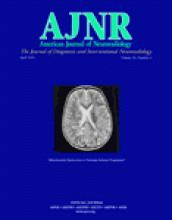Abstract
BACKGROUND AND PURPOSE: The association of high-grade oligodendrogliomas with tumor contrast material enhancement on MR images has been reported. Some authors have even used contrast enhancement as a criterion for their oligodendroglioma grading system. The purpose of our study was to evaluate if tumor contrast enhancement is a specific finding for anaplastic oligodendroglioma.
METHODS: Pretreatment MR images of 24 oligodendrogliomas were reviewed retrospectively, and findings were compared with the histologic grade. The presence or absence and the pattern of tumor contrast enhancement were evaluated qualitatively. A contrast enhancement ratio (CER), a quantitative criterion, was calculated to assess the difference in degree of enhancement between the low-grade and anaplastic tumors. Tumor grade was diagnosed at pathologic examination according to the World Health Organization classification system.
RESULTS: Contrast enhancement was noted in nine (56%) of 16 low-grade tumors and in five (62%) of eight anaplastic tumors. A characteristic enhancement pattern, nodular-like enhancement, was found in eight tumors. The CERs were 2.12–40.88 (mean, 20.08) in low-grade tumors and were 3.20–62.52 (mean, 28.73) in anaplastic tumors (P > .05).
CONCLUSION: Tumor contrast enhancement was not statistically significantly different between the tumor groups. We believe that the presence or absence of tumor contrast enhancement is not a specific finding for simply discriminating low-grade from anaplastic oligodendrogliomas. Histologic confirmation is necessary even in tumors without contrast enhancement.
- American Society of Neuroradiology












